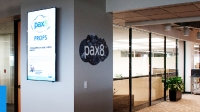On-Premise Digital Signage Software vs Cloud-Based Digital Signage Software
By
— March 3rd, 2025

The business landscape is continuously evolving, pushing companies toward digital transformation. In this arena, digital signage has emerged as a key player, offering an efficient and impactful medium for communication—for customers as well as employees.
From local server-based setups to on-premise (ok, technically, we know it’s on-premises, but for the sake of conversation, we’re going to stick with “on-premise” for this article) digital signage software, and even cloud-based solutions, businesses have varied options to choose from. This blog will explore these facets and outline how they cater to different business needs, ensuring a seamless digital signage experience. Let’s get into the specifics of each setup:
Digital Signage Local Server
A digital signage local server setup involves managing the digital signage content through servers hosted on-premises within an organization's local area network. This model offers enhanced control over the content distribution network, assuring robust data security and low latency for delivering real-time updates. IT administrators appreciate the ability to maintain full governance over the hardware, software, and network resources, reducing dependencies on internet connectivity. This approach enhances the reliability of displaying critical, time-sensitive information across digital signage endpoints.
For instance, some of Poppulo’s large manufacturing clients choose to deploy a local server-based digital signage system in their facilities to further ensure system safety. This on-premises setup empowered floor managers and technicians with instantaneous access to real-time production data, equipment statuses, and safety protocols, significantly improving operational efficiencies while meeting stringent security requirements typical of the defense industry. By hosting the digital signage platform on local servers within their secure network infrastructure, these organizations streamline content updates and system maintenance to align with rigorous governance protocols.
The ability to leverage a digital signage local server provides organizations with a centralized, on-premises solution for managing digital signage networks. This approach ensures consistent, low-latency delivery of dynamic content while maintaining complete control over security, scalability, and regulatory compliance within the local network infrastructure.
On-Premises Digital Signage Software
This is where things get a little confusing, because while using a digital signage server is technically on-premise, it is not exactly the same as having an on-premise digital signage setup. In essence, while all local server setups are on-premise, not all on-premise setups are limited to a single server-based model; on-premise solutions can encompass a broader range of in-house hosted systems and applications.
On-premise digital signage software offers a robust solution where all the signage operations are managed in-house. This is particularly advantageous for organizations needing stringent security controls and regulatory compliance, such as in finance or healthcare sectors. The Poppulo Digital Signage platform is an exemplary solution that supports extensive security measures like ISO 27001 and SOC2 compliance, ensuring that sensitive content is managed securely—this is done for both on-premise and cloud-based solutions.
By leveraging on-premise digital signage software, companies can also integrate other internal systems, enhancing content relevancy by displaying dynamic, real-time data. Whether it’s performance dashboards in manufacturing plants or real-time arrival information in transportation hubs, the ability to control and customize content on-premises ensures that the communication is timely and accurate.
Digital Signage Cloud
Transitioning to the digital signage cloud can unlock numerous benefits, particularly for businesses looking to reduce costs associated with infrastructure and maintenance. A cloud-based system centralizes content management, providing unparalleled scalability and remote accessibility. This model supports a wide range of use cases, from centralized governance in retail networks to employee engagement in corporate environments.
A digital signage cloud solution facilitates easy scalability, allowing businesses to seamlessly integrate new screens and locations into their existing network without hefty investments in additional local servers or extensive IT support. A centralized content repository enables creating, uploading, and scheduling content remotely, enhancing convenience and efficiency for distributed teams.
For instance, retail chains can dynamically update promotions across all locations, ensuring consistency and immediacy in marketing efforts, significantly improving customer engagement and sales. Moreover, features like real-time data integration ensure that content remains relevant and effective, fostering an interactive and engaging customer experience.
Security and Performance: Addressing Concerns
A common concern with adopting digital signage cloud solutions revolves around security risks. However, robust digital signage platforms, like Poppulo, prioritize security by implementing advanced measures, such as permission-based access controls and regular security audits. These controls ensure that only authorized personnel can manage content and settings, significantly reducing the risk of data breaches.
Performance optimization is another critical aspect of cloud-based solutions. Regular updates and system enhancements can be rolled out without the need for significant downtime, ensuring that your digital signage network remains up-to-date with the latest features and security patches.
Enhanced User Experience
Administrators managing digital signage systems, whether on-premise or cloud-based, benefit from enhanced control and visibility. The Poppulo digital signage Cloud, for instance, offers user-based permissions, SSO integrations, and real-time monitoring to ensure seamless operations across all devices in the network.
And content contributors can swiftly publish dynamic content using mobile-friendly tools, encouraging different departments to manage content on their screens, independently. This democratization of content creation ensures audience engagement and enables digital signage to be used to solve more than one challenge.
Conclusion
The choice between a digital signage local server, on-premise digital signage software, and a digital signage cloud largely depends on your specific needs, resources, and security requirements. And in some instances, the right solution might not be so cut-and-dry. We’ve installed hybrid solutions when needed, and have extensive knowledge and best practices for each hosting methodology.
Each model offers distinct advantages, from enhanced control and security in on-premise setups to the flexibility and scalability of cloud-based solutions. By understanding the unique benefits and applications of each, businesses can make informed decisions to optimize their digital signage strategy, ultimately driving engagement, performance, and growth.
If you’re interested in integrating a cutting-edge digital signage solution into your business, contact us for an in-depth consultation. We are committed to helping you navigate the digital transformation landscape with ease and confidence.
FAQs for On Premise Vs Cloud Digital Signage
Are there hybrid digital signage solutions that combine both on-premise and cloud features?
Yes, there are hybrid digital signage solutions that allow organizations to combine the benefits of both on-premise and cloud deployment models. The retrieved documents mention that a hybrid approach enables hosting the digital signage platform and managing core content distribution from the cloud, while keeping specific data sets or applications on-premise. This provides flexibility to leverage cloud scalability while maintaining control over sensitive data and critical systems within the local network infrastructure.
What are the maintenance requirements for on-premise digital signage servers?
The documents highlight that maintaining on-premise digital signage servers requires ongoing effort from an organization's internal IT team. This includes hardware maintenance, applying software updates and security patches, implementing data backups, security monitoring, performance tuning, and executing infrastructure upgrades as needed. On-premise server maintenance can be resource-intensive, requiring dedicated IT personnel and a commitment to operational costs.
How can I set up a local server for digital signage in my organization?
While the documents do not provide step-by-step instructions, they suggest that setting up a local server for digital signage involves assessing requirements, procuring necessary hardware, configuring the server environment, installing the digital signage software platform, integrating with existing systems, setting up displays and players, implementing security measures, and developing a maintenance plan. Involvement of experienced IT personnel or guidance from digital signage experts is recommended for a proper and secure implementation.
What are the security implications of using cloud-based digital signage platforms?
The documents mention several security implications to consider when using cloud-based digital signage platforms, including data privacy and compliance with relevant regulations, implementing robust access control and authentication measures, ensuring data encryption, evaluating the cloud provider's security practices, protection against Distributed Denial of Service (DDoS) attacks, backup and disaster recovery strategies, and potential risks of vendor lock-in and data portability.
What are the advantages of using on-premise digital signage solutions over cloud-based options?
According to the retrieved information, some advantages of using on-premise digital signage solutions over cloud-based options include data control and security, compliance with governance policies, network independence, flexibility for customization and integration, potential long-term cost savings by eliminating subscription fees, and physical control over hardware and infrastructure.








